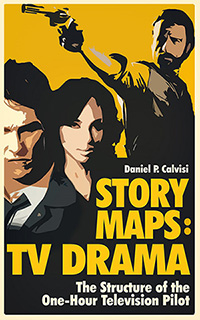Article
Getting Up to Speed: What You Need to Start Writing a TV Pilot
Written by: Daniel CalvisiPublished: Sep 9, 2015
Daniel Calvisi’s next TV PILOT MASTER CLASS begins on September 15, 2015 and there are only a couple spots left! Working Manager and Producer LEE STOBBY is on board the 8-week online workshop as Senior Advisor, and the Master Class is the first and only course to offer GUARANTEED SUBMISSION of your completed pilot! Go to http://eepurl.com/bx7xiD for more information.
Scripted television is exploding. And if you are a screenwriter with experience primarily in the feature-length form, then you would do yourself well to start learning how to write a pilot.
It may seem daunting to make the switch from features to television, but it’s easier than you might think. Your first step should be to familiarize yourself with the landscape of television writing, and that begins with learning the basic formats and key terminology used in the industry. This knowledge will help inform how you construct your original television series and its first episode, the pilot. I call this process “story mapping.”
Before you dive in, please know this first bit of good news: In television, CONTENT IS KING! That is great news for screenwriters looking to break into this rapidly expanding industry. A decade ago, reality TV ruled the roost, but now it’s all about STORY. The television industry (or industries, considering all the different platforms in use) needs writers who understand character-driven narrative structure and technique.
There are more channels and platforms that distribute scripted content than ever. Many cable channels that were established with documentary/reality shows are now turning to scripted content, and websites are buying pitches and pilots every day. Even cable delivery services like DirectTV and video gaming platforms like Xbox and PlayStation are producing original content.
Before you begin writing your pilot, consider the landscape and how your show may fit within it. You must first know the players, and then do your research to find out their individual “brand,” which often corresponds with their target demographic, or audience. (E.g., ABC Family targets tweens, so don’t bother submitting your serial killer procedural to them.) These are the most active networks in the United States:
- “Broadcast” or “Major” Networks: ABC, CBS, NBC and FOX
- “Premium” Cable Networks: HBO, SHOWTIME, STARZ, CINEMAX
- “Basic” Cable Networks: ABC FAMILY, A&E, AMC, BRAVO, COMEDY CENTRAL, DISCOVERY, DISNEY, FX, FXX, HISTORY, IFC, MTV, TBS, TNT, SUNDANCE, USA, WGN
- Internet (subscription-based or free): Netflix, Amazon, Hulu, YouTube, Yahoo, AOL, MSN, Crackle
Amazingly, I know I know this list is not complete. I’m definitely missing a few networks!
Keep in mind that the networks listed above are not always the production companies that make the shows. For example, Lionsgate Television produced Mad Men, which aired on AMC.
CORE FORMATS
There are very specific formats for scripted shows on U.S. television. You must know the differences in formats to decide which type of show you plan to write.
- 1-Hour Drama/Dramedy: A 60-minute show with or without commercials. (Game of Thrones, The Good Wife, Homeland)
- 30-Minute Single-Camera Sitcom: A comedy shot like a movie. (The Office, Curb Your Enthusiasm, New Girl, Veep)
- 30-Minute Multi-Camera Sitcom: A sitcom that uses a laugh track. Shot mostly in a studio, perhaps in front of a live audience. (Two Broke Girls, How I Met Your Mother, The Big Bang Theory)
- 30-Minute Dramedy Hybrid: We’re seeing more shows in the 30-minute running time that use a unique mix of drama and comedy. Transparent and Girls are notable examples.
- Web Series: A short form narrative video series. Length varies, but 3-8 minutes per episode is a common range. Webisodes are often used as pitch reels to sell a longer-form series. (Various series on Hulu, YouTube, Crackle)
PROCEDURAL VS. SERIAL
A procedural series is one that consists of self-contained or stand-alone stories. Each episode introduces a specific dramatic dilemma that the characters must solve by the end of the episode. This is also known as “case-of-the-week.” In a procedural, the weekly case is the focus, while the ongoing arcs and themes, if any, are secondary. Common procedurals are police, lawyer, and medical dramas such as CSI, Chicago PD, Grey’s Anatomy, etc.
A serial or serialized show is one that comprises overarching storylines/character arcs that develop over the course of the season or series. These ongoing stories and themes take precedent and build towards a gradual climax. While serialized TV shows can contain “case-of-the-week’” stories, they are often secondary and used instead to explore/reflect the larger story/themes. Serialized TV shows are best aired and viewed in narrative order to prevent viewers from becoming confused and losing pace with plot developments. These shows perform well on DVR, DVD and streaming, which allow fans to watch at their own pace. Examples would be Lost, Mad Men, The Walking Dead and most premium-cable dramas like Game of Thrones and Homeland.
Serial/Procedural Hybrids are also a popular form, and can vary in their construction. This usually means that a show will alternate between a case-of-the-week episode and a “mythology” episode that advances a long term narrative arc. A classic example of this form would be The X-Files, which alternated between “monster-of-the-week” episodes and episodes about the ongoing saga of the Smoking Man and a potential alien invasion (which also tied into Fox Mulder’s backstory with his missing sister). Like many hybrid shows, the mythology became more dominant as the series went on. A hybrid show can also combine a case and mythology in a single episode, as in many episodes of Dexter, where Dexter Morgan hunts a new target and he evades his sister or others as they get closer to learning his deadly secret.
There are benefits to both formats...
| Serial: | Procedural: |
|
|
PILOT VS. SPEC
A “pilot” script is an original screenplay for the first episode of a series. A great pilot script is the only firm requirement to break into the business of writing television.
A “spec” script is an original episode of an existing show, written as a writing sample to show that you can write in a specific genre and within an established set of dramatic parameters. If your goal is to join a writing staff, it’s important to show that you can be a team player and write effectively in someone else’s voice by “specing” a current series. Specs are not written as commonly these days by aspiring writers, but are sometimes requested as writing samples after a writer gets noticed for an original pilot. At the least, it’s good practice to write in your intended genre; e.g., if you want to write one hour crime procedurals, then you could write a spec episode of Chicago P.D. (or whatever the current incarnation of Chicago P.D. may be). Keep in mind that a TV spec is different than a feature spec.
“PREMISE” PILOT VS. “3RD EPISODE” PILOT
The term “premise pilot” denotes a pilot that takes the entire script to fully set up the story that will be continued in future episodes. The structure of the pilot does not represent the structure of a regular episode of the series. The Walking Dead is an example of a premise pilot; there is a lot of ground to cover in setting up the zombie-infested world, so Rick Grimes is the “newborn” who takes us through it. We discover this new world as he does. In future episodes, he has met up with other survivors and they must tackle problems as a group.
On the contrary, a pilot that throws us into the action, with the premise already set up, is sometimes called a “third episode,” as in it uses the same structure as the third episode would use, when the series engine is established. Scandal is an example of a third episode pilot; Olivia Pope and her employees are already well-seasoned in what they do, and we are brought up to speed quickly. The case-of-the-week begins six minutes into the pilot when Lt. Colonel “Sully” St. James walks into Olivia’s agency, covered in blood, and says he didn’t kill his girlfriend. If Scandal was a premise pilot, we may have opened with Olivia Pope graduating law school and taking her first job, and maybe Act One would end with her opening up her own firm.
 Kerry Washington as Olivia Pope in Scandal
Kerry Washington as Olivia Pope in Scandal
No matter which type of pilot you write, it always helps to begin the story as soon as possible. Cut out anything that only exists as setup or exposition without advancing the central throughline of the episode.
Enter the action of your story as late as possible in the world but as soon as possible in the script.
Does that make sense? Think of it like this: if your world is homicide detectives in New York City, do you begin the story in the police academy or once our protagonist is already on the job? Do you open on them getting coffee at Starbucks or walking into a luxury loft where a beat cop ushers them to the dead body on the kitchen floor? In both cases, I’d go with the latter option, unless the former option can be written so as to immediately advance the present line of action.
There’s no time to waste. The reader is anxious. Get to the good stuff ASAP.
It should be noted that in the original pilot script for “Scandal,” Sully walks into the agency on page 12, which would have corresponded to 12 minutes into the episode. They wisely moved up this Inciting Incident for the actual episode to minute six, getting the case started in half the time. Most competent rewrites trim the fat and get the story moving quicker, while maintaining the same essential beats and character moments in the first act. They just do it with fewer words, which just so happens to be one of the central skills of the experienced screenwriter, whether in a feature screenplay or television pilot.
Good luck and happy writing,
Daniel Calvisi
p.s. The above article is excerpted from my upcoming book, Story Maps: TV Drama: The Structure of the One-Hour Pilot, available soon at actfourscreenplays.com.
 p.s.s. If you would like to write a pilot in an online course that gives you weekly notes from a professional Story Analyst, your peers and two working industry professionals, including a manager, please consider my STORY MAPS TV PILOT MASTER CLASS. The next group class begins on Tuesday, September 15, 2015, and private courses can begin at any time. If you would like more information please go to http://actfourscreenplays.com/tvpilot/
p.s.s. If you would like to write a pilot in an online course that gives you weekly notes from a professional Story Analyst, your peers and two working industry professionals, including a manager, please consider my STORY MAPS TV PILOT MASTER CLASS. The next group class begins on Tuesday, September 15, 2015, and private courses can begin at any time. If you would like more information please go to http://actfourscreenplays.com/tvpilot/
Daniel P. Calvisi 
Go to ActFourScreenplays.com for more about him, Story Maps, and to listen to the Story Maps Screenwriting Podcast.
Follow Dan on Twitter: @StoryMapsDan.
